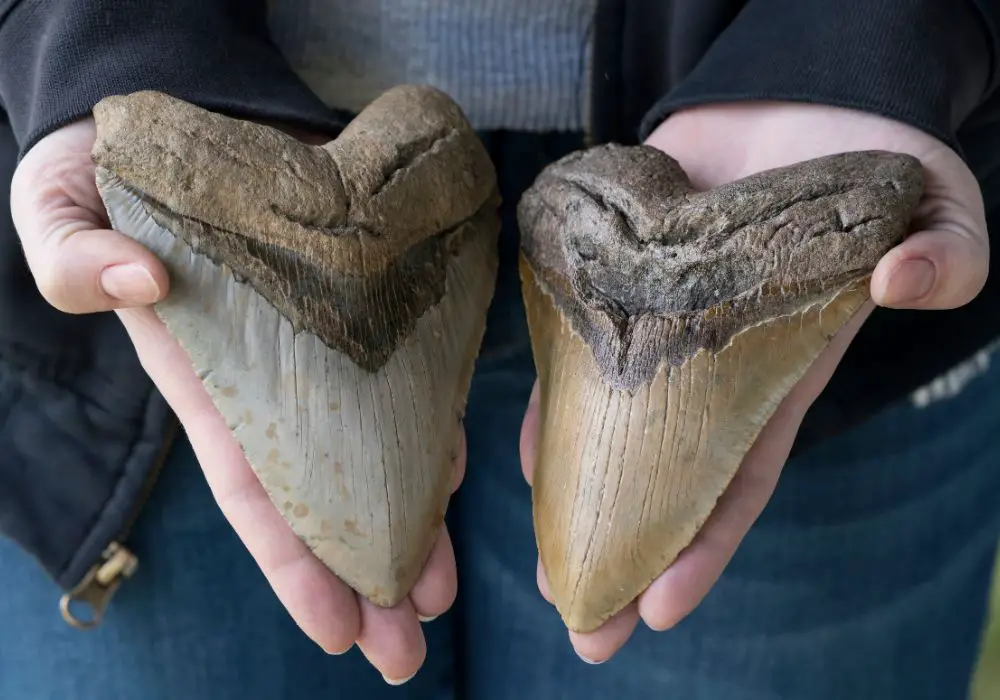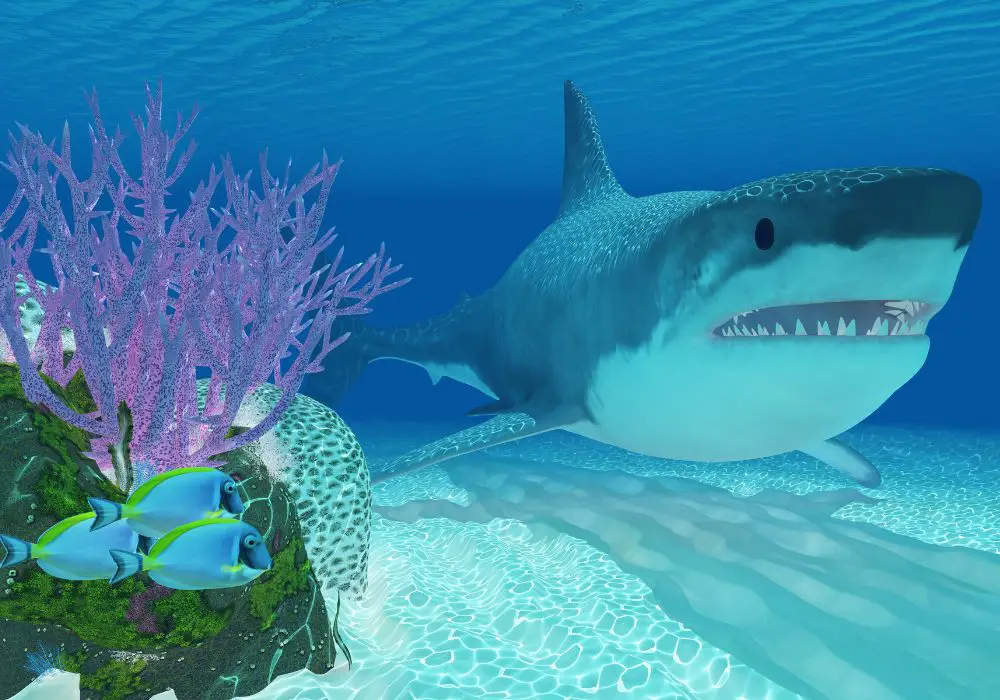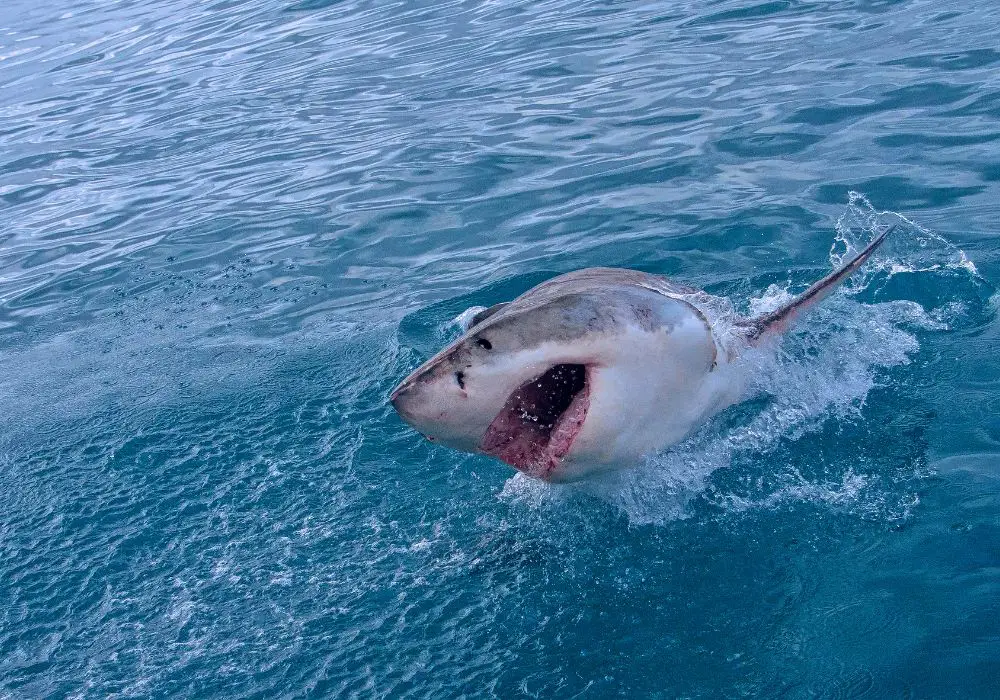Are you an avid collector of shark teeth? If so, you may have come across a tooth that you suspect could be from the prehistoric megalodon shark. But how can you tell for sure? In this article, we will provide you with some tips and tricks to help you identify whether a shark tooth is from a megalodon or another species.
One of the most significant factors in identifying a megalodon tooth is its size. Megalodon teeth are generally larger than those of other shark species, ranging from as small as 1 inch to over 7 inches in length. If you have a tooth that is larger than average, it could be a megalodon tooth. However, keep in mind that the size alone is not a definitive indicator, as some other shark species can also have large teeth.
Another characteristic to look for is the tooth’s shape. Megalodon teeth have a unique triangular shape, with serrated edges that are designed for cutting through the tough skin and bones of prey. If the tooth has a similar shape and serrations, it could be a megalodon tooth. However, some other shark species also have triangular teeth, so it is essential to consider other factors as well.
Understanding Shark Teeth

Shark teeth are fascinating and unique, and they can tell us a lot about these fascinating creatures. If you’re interested in identifying shark teeth, it’s important to understand the basic anatomy and different types of teeth.
Basic Anatomy of Shark Teeth
Shark teeth are made up of three basic parts: the crown, the root, and the neck. The crown is the visible part of the tooth that protrudes from the gum line. The root is the part of the tooth that is embedded in the jaw. The neck is the area where the crown and root meet.
Shark teeth are also covered in enamel, which is the hardest substance in the body. This makes them incredibly durable and resistant to decay.
Types of Shark Teeth
There are several different types of shark teeth, each with its own unique shape and purpose. Some of the most common types of shark teeth include:
- Pointed Teeth: These teeth are long and pointed, and are used for grabbing and holding onto prey.
- Flat Teeth: These teeth are broad and flat, and are used for crushing and grinding prey.
- Serrated Teeth: These teeth have jagged edges, and are used for cutting through tough prey like fish and squid.
- Needle-Like Teeth: These teeth are long and slender, and are used for spearing prey like fish.
It’s important to note that not all sharks have the same types of teeth. Some sharks, like the great white, have a combination of different tooth types, while others, like the hammerhead, have more specialized teeth.
By understanding the basic anatomy and different types of shark teeth, you’ll be better equipped to identify the teeth you come across. Whether you’re a seasoned collector or just starting out, there’s always more to learn about these fascinating creatures.
Identifying Megalodon Teeth
If you’re a fan of fossils and shark teeth, you’ve probably heard of the Megalodon, the largest shark that ever lived. Megalodon teeth are highly sought after by collectors and enthusiasts, but how can you tell if a shark tooth is a Megalodon tooth? In this section, we’ll explore the key features that can help you identify a Megalodon tooth.
Size and Shape
One of the most obvious ways to identify a Megalodon tooth is by its size. Megalodon teeth can range from 1 inch to over 7 inches in length, with some specimens reaching up to 7 inches. The shape of the tooth can also be a clue. Megalodon teeth are typically triangular and symmetrical, with a broad base and a pointed tip.
Color and Texture
The color and texture of a Megalodon tooth can also provide clues to its identity. Megalodon teeth are usually a dark gray or black color, but can also be brown or tan. The texture of the tooth can vary, but most Megalodon teeth have a smooth enamel surface with fine serrations along the edges.
Root and Bourlette
Unlike other shark teeth, Megalodon teeth have a distinct feature called a bourlette. This is a dark, triangular-shaped area near the base of the tooth. The root of the tooth can also be a clue to its identity. Megalodon teeth have a deep, wide root that is often wider than the tooth itself.
| Feature | Megalodon Tooth |
|---|---|
| Size | 1-7+ inches |
| Shape | Triangular and symmetrical |
| Color | Dark gray or black, sometimes brown or tan |
| Texture | Smooth enamel with fine serrations |
| Bourlette | Dark, triangular-shaped area near the base |
| Root | Deep, wide root wider than the tooth |
By looking for these key features, you can identify a Megalodon tooth with confidence. Remember, not all shark teeth are Megalodon teeth, so it’s important to pay attention to the details. Happy hunting!
Comparing With Other Shark Teeth

Megalodon Vs Great White Shark Teeth
When comparing megalodon teeth to great white shark teeth, there are a few key differences to look out for. Megalodon teeth are much larger than great white shark teeth, with some megalodon teeth reaching up to 7 inches in length. Great white shark teeth, on the other hand, typically only reach up to 3 inches in length. Additionally, megalodon teeth have a more triangular shape compared to the more pointed shape of great white shark teeth.
Another difference between megalodon and great white shark teeth is the serrations, or the small ridges along the edges of the tooth. Megalodon teeth have much larger and more pronounced serrations compared to great white shark teeth. These serrations were likely used to help the megalodon crush and break apart its prey.
Megalodon Vs Tiger Shark Teeth
When comparing megalodon teeth to tiger shark teeth, there are also some notable differences. While both megalodon and tiger shark teeth are triangular in shape, megalodon teeth are much larger. Tiger shark teeth typically only reach up to 3 inches in length, while megalodon teeth can be over 7 inches long.
Another difference is the serrations on the teeth. Megalodon teeth have much larger and more pronounced serrations compared to tiger shark teeth. Additionally, megalodon teeth have a more curved shape compared to the more straight shape of tiger shark teeth.
Overall, when trying to identify a megalodon tooth, it is important to look for a large, triangular tooth with pronounced serrations. While there are some similarities between megalodon teeth and the teeth of other sharks, the sheer size and shape of megalodon teeth make them fairly easy to identify once you know what to look for.
Location and Environment
When it comes to identifying whether a shark tooth is from a megalodon or not, the location and environment where it was found can provide valuable clues. Megalodon teeth have been found all over the world, but they are most commonly found in the following areas:
- Coastal regions of the southeastern United States, including Florida, Georgia, and the Carolinas
- Coastal regions of South America, including Peru, Chile, and Brazil
- Coastal regions of Europe, including Portugal and Spain
- Coastal regions of Australia
Megalodon fossils have also been found in areas that were once shallow seas, such as the Miocene and Pliocene deposits of California and the Chesapeake Bay region of Virginia.
In addition to location, the environment where the tooth was found can also provide clues. Megalodon teeth are typically found in sediments that were deposited in shallow marine environments, such as beaches, sandbars, and nearshore waters. These sediments are often composed of sand, shell fragments, and other marine debris.
It’s important to note that just because a tooth was found in one of these areas doesn’t necessarily mean it’s from a megalodon. Other shark species, such as the great white shark and the tiger shark, also inhabit these areas and can leave behind teeth that are similar in appearance to megalodon teeth. However, if you find a tooth in one of these areas that is larger than 3 inches in length and has a characteristic triangular shape with serrated edges, it’s possible that it could be a megalodon tooth.
Age and Preservation of Megalodon Teeth

Megalodon teeth are fossils that are millions of years old and can be found in various parts of the world. Fossils are the preserved remains of ancient organisms, and they can provide valuable information about the past.
Megalodon teeth are typically found in sedimentary rock formations, which are rocks that are formed from the accumulation of sediment over time. These rocks are usually found in areas that were once covered by water, such as ocean floors or riverbeds.
The preservation of megalodon teeth is due to the process of fossilization. Fossilization occurs when the organic material of an organism is replaced by minerals over time. In the case of megalodon teeth, minerals in the surrounding sediment seep into the tooth and replace the original material, resulting in a fossilized tooth.
The color of megalodon teeth can vary depending on their preservation. Some megalodon teeth are black because they have been buried for a long time and have absorbed minerals from the surrounding sediment. Others may be a lighter color if they have not been buried as long.
It is important to note that not all megalodon teeth are in pristine condition. Some teeth may be broken or damaged, while others may have been restored or repaired. When purchasing megalodon teeth, it is important to buy from a trusted source and to carefully examine the tooth for any signs of restoration or repair.
In summary, megalodon teeth are fossils that are millions of years old and are typically found in sedimentary rock formations. The preservation of megalodon teeth is due to the process of fossilization, and their color can vary depending on their preservation. When purchasing megalodon teeth, it is important to buy from a trusted source and to carefully examine the tooth for any signs of restoration or repair.
Frequently Asked Questions
What are the characteristics of a megalodon tooth?
Megalodon teeth are generally larger than those of other shark species. They can range from as small as 1 inch (2.54 cm) to over 7 inches (18 cm) in length. The size of the tooth can give a good indication of whether it could be a megalodon tooth. Megalodon teeth also have a triangular shape and a serrated edge.
How do you differentiate megalodon teeth from other shark teeth?
Megalodon teeth can be differentiated from other shark teeth by their size and shape. Megalodon teeth have a triangular shape and a serrated edge. They are also much larger than other shark teeth. However, it is important to note that some other shark species, such as the great white and the mako, have teeth that are similar in shape and size to megalodon teeth.
What is the average size of a megalodon tooth?
The average size of a megalodon tooth is around 4-5 inches (10-12 cm) in length. However, megalodon teeth can range in size from as small as 1 inch (2.54 cm) to over 7 inches (18 cm) in length.
What is the rarity and value of megalodon teeth?
Megalodon teeth are rare and valuable because the megalodon shark went extinct over 2 million years ago. The value of a megalodon tooth depends on its size, condition, and rarity. Large, well-preserved megalodon teeth can be worth thousands of dollars.
What are the most common locations to find megalodon teeth?
Megalodon teeth can be found in many locations around the world, including the United States, South America, and Europe. Some of the most common locations to find megalodon teeth include the coasts of Florida, South Carolina, and California.
What are some tips for identifying fossilized shark teeth?
When identifying fossilized shark teeth, it is important to look for the shape, size, and serrations of the tooth. Megalodon teeth have a triangular shape and a serrated edge, while other shark teeth may have a different shape or edge. It is also important to consider the location where the tooth was found, as this can help identify the species of shark. Finally, it is important to note that fossilized shark teeth may be worn or damaged, so it is important to carefully examine the tooth to determine its characteristics.







